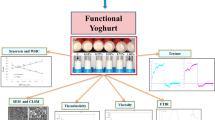Abstract
Oil bodies (OBs), one of the major components of soymilk, are very important for the properties of soymilk and its related products. In this study, the properties and the related protein behaviors of OBs in the soymilk preparation were systematically examined. Raw soymilk OBs could keep their natural integrities after grinding, and they were bound by many soybean proteins (mainly β-conglycinin, glycinin, and Gly m Bd 30K) that could be removed by pH 11.0 washing. Heated soymilk OBs, including heat-induced coalesced OBs (>1 μm) and modified OBs (around 400 nm), were strongly bound by β-conglycinin and glycinin that even could not be removed by pH 11.0 washing. The oleosins (24 kDa, P29530 and P29531; 18 kDa, C3VHQ8) of raw soymilk OBs were hydrolyzed to 16 kDa polypeptides (on SDS–PAGE gel) when exposed to room temperature, while immediately heating, the raw soymilk could prevent the oleosin hydrolysis. Then, the isolated raw and heated soymilk OBs revealed different dispersion stabilities as a function of pH. At last, tofu curds were made from two reconstituted soymilks containing non-lipid soymilk and raw or heated soymilk OBs (pH 11.0 isolation), and one trend was found that tofu curds containing heated soymilk OBs had lower breaking stress and Young’s modulus than those containing raw soymilk OBs. It is considered that this study is meaningful for designing new strategies to improve the qualities of soymilk and its related products.





Similar content being viewed by others
References
Obatolu VA (2008) Effect of different coagulants on yield and quality of tofu from soymilk. Eur Food Res Technol 226:467–472
Chen Y, Yamaguchi S, Ono T (2009) Mechanism of the chemical composition changes of yuba prepared by a laboratory processing method. J Agric Food Chem 57:3831–3836
Chang Y, Su H, Shiau S (2009) Rheological and textural characteristics of black soybean touhua (soft soybean curd) prepared with glucono-δ-lactone. Food Chem 115:585–591
Rossi EA, Vendramini RC, Carlos IZ, Pei YC, de Valdez GF (1999) Development of a novel fermented soymilk product with potential probiotic properties. Eur Food Res Technol 209(5):305–307
Ono T (2008) The mechanism of soymilk and tofu formation from soybean, and the factors affecting the formation. J Jpn Soc Food Sci (in Japanese) 55(2):39–48
Ono T, Choi MR, Ikeda A, Odagiri S (1991) Changes in the composition and size distribution of soymilk protein particles by heating. Agric Biol Chem 55:2291–2297
Huang AHC (1992) Oil bodies and oleosins in seeds. Annu Rev Plant Physiol Plant Mol Biol 43:177–200
Chen Y, Ono T (2010) Simple extraction method of non-allergenic intact soybean oil bodies that are thermally stable in an aqueous medium. J Agric Food Chem 58:7402–7407
Zhao L, Chen Y, Cao Y, Kong X, Hua Y (2013) The integral and extrinsic bioactive proteins in the aqueous extracted soybean oil bodies. J Agric Food Chem 61(40):9727–9733
Hildebrand DF (1989) Lipoxygenases. Physiol Plant 76:249–253
Chen Y, Ono T (2010) The mechanisms for Yuba formation and its stable lipid. J Agric Food Chem 58(10):6485–6489
Tzen JTC, Huang AHC (1992) Surface structure and properties of plant seed oil bodies. J Cell Biol 117:327–335
Laemmli UK (1970) Cleavage of structural proteins during the assembly of the head of bacteriophage T4. Nature 227:680–685
Krishnan HB (2008) Preparative procedures markedly influence the appearance and structural integrity of protein storage vacuoles in soybean seeds. J Agric Food Chem 56:2907–2912
Toda K, Chiba K, Ono T (2007) Effect of components extracted from okara on the physicochemical properties of soymilk and tofu texture. J Food Sci 72(2):108–113
Cruz N, Capellas M, Hernandez M, Trujillo AJ, Guamis B, Ferragut V (2007) Ultra high pressure homogenization of soymilk: microbiological, physicochemical and microstructural characteristics. Food Res Int 40:725–732
Waschatko G, Schiedt B, Vilgis TA, Junghans A (2012) Soybean oleosomes behavior at the air-water interface. J Phys Chem B 116(35):10832–10841
Zhang Y, Guo S, Liu Z, Chang SKC (2012) Off-flavor related volatiles in soymilk as affected by soybean variety, grinding, and heat-processing methods. J Agric Food Chem 60:7457–7462
Frandsen GI, Mundy J, Tzen JTC (2001) Oil bodies and their associated proteins, oleosin and caleosin. Physiol Plant 112(3):301–307
Murphy DJ, Cummins I (1989) Seed oil-bodies: isolation, composition and role of oil-body apolipoproteins. Phytochemistry 28(8):2063–2069
Murphy DI, Hernandez-Pinzon I, Patel K (2001) Role of lipid bodies and lipid-body proteins in seeds and other tissues. J Plant Physiol 158(4):471–478
Tzen JTC, Cao YZ, Laurent P, Ratnayake C, Huang AHC (1993) Lipids, proteins, and structures of seed oil bodies from diverse species. Plant Physiol 101(1):267–276
Guo S, Ono T (2005) The role of composition and content of protein particles in soymilk on tofu curding by glucono-δ-lactone or calcium sulfate. J Food Sci 70(4):258–262
Ono T, Katho S, Mothizuki K (1993) Influences of calcium and pH on protein solubility in soybean milk. Biosci Biotech Biochem 57(1):24–28
Liu Z, Chang SKC (2010) Chemical characteristics of low-fat soymilk prepared by low-speed centrifugal fraction of the raw soymilk. J Food Sci 75(5):420–427
Acknowledgments
We gratefully acknowledge the financial support received from Natural Science Foundation of China (31301496), Fundamental Research Fund of Ministry of Education (2050205), Natural Science Foundation of China (31201380), Natural Science Foundation of Jiangsu Province, PR China (BK2011151), and the Open Project Program of State Key Laboratory of Food Science and Technology, Jiangnan University (SKLF-ZZB-201202).
Conflict of interest
None.
Compliance with Ethics Requirements
This article does not contain any studies with human or animal subjects.
Author information
Authors and Affiliations
Corresponding author
Rights and permissions
About this article
Cite this article
Chen, Y., Zhao, L., Kong, X. et al. The properties and the related protein behaviors of oil bodies in soymilk preparation. Eur Food Res Technol 239, 463–471 (2014). https://doi.org/10.1007/s00217-014-2239-3
Received:
Revised:
Accepted:
Published:
Issue Date:
DOI: https://doi.org/10.1007/s00217-014-2239-3




